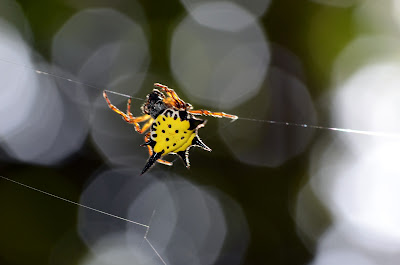In many warmer parts of the Old World, the spiny orb-weavers of the subfamily Gasteracanthinae are among the most eye-catching of all spiders. As well as constructing complex, easily seen webs in the manner of other orb-weavers, these spiders draw attention by their bright colours and ornate structure, often with prominent arrangements of spines on the abdomen. Here in Australia, their dramatic appearance has lead to their often being referred to as "Christmas spiders". The exact reason for this drama is uncertain. The spines are generally presumed to be for defence but the coloration has been subject to multiple proposals from an aposematic warning to functioning as a lure for flying insects.
The taxonomic history of the Christmas spiders is a complicated one, going back to the early years of arachnology. Not surprisingly for such distinctive animals, a large number of species were described by early authors. However, species of spiny orb-weavers are often very variable, leading to a significant number being described as new on more than one occasion. As with other orb-weavers, males are much smaller than females, and the spines on the abdomen tend to be more poorly developed. Coloration within a species can vary considerably in brightness, tone, and patterning. Structural features such as the arrangement of spines and the development of sigilla (impressions on the dorsal surface of the abdomen that mark the placement of internal muscles) can still provide reliable indicators of species identity, as (of course) can features of the genitalia. You have to learn to look past the superficial daubings and focus on the underlying form.


No comments:
Post a Comment